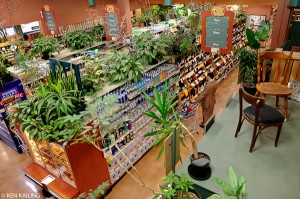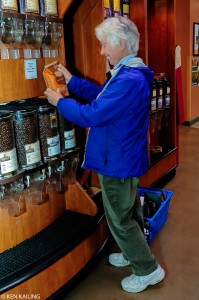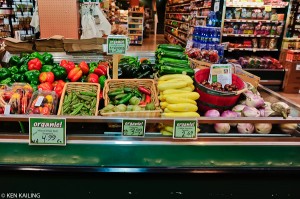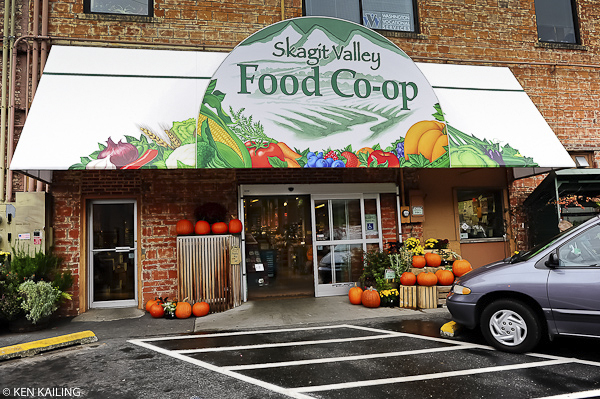Like Goldilocks in search of “just right,” local food markets struggle with size.
On the “Too Small” end, we are seeing markets in small rural communities disappear. In towns with populations of 3,000 or fewer are rapidly losing their food markets as shoppers drive to Walmart, Costco, or large grocery chains.
On the “Too Big” end, we see “supernaturals” like Whole Foods and Trader Joe’s descending en masse on large urban areas. For example, in Seattle, there are 5 Whole Foods Markets and 8 Trader Joe’s within 15 miles of my home. Add 9 PCC Natural Markets – the largest natural food co-op “chain” in the US – and shoppers have plenty of options to buy healthy, local food.
For communities with populations of 25,00 to 50,000 people, markets like Skagit Valley Food Co-op find the size “Just Right!” Mount Vernon, Washington, (population around 28,000) is located on the banks of the Skagit River, which flows through a fertile valley where agriculture is still a major industry.
(Take a virtual tour of Skagit Valley Food Co-op here.)
Todd Wood, Skagit Valley Food Co-op general manager, shared the co-op’s strategies for differentiation, views on community support, and local sourcing policies with GoodFood World.

GoodFood World: How do you keep your shoppers “down home” when the competition is a fairly short drive away? How are you differentiating your store?
Todd Wood: Today we all offer pretty much the same products in the “center of the store,” where the packaged and prepared foods are located. If you walk down our aisles, you’ll see exactly the same products on the shelves that you can find at Whole Foods. It’s tough to differentiate there.
We can compete by focusing on the perimeter of the store. We do a good job in produce, we have a growing personal care department, and our food service ranges from deli items and bakery to ice cream.
The Mount Vernon downtown is like many small towns; the last bakery closed 5 years ago, and we’re actually located in the old JC Penny’s department store. The “anchor” stores have gone away.
Over the last 35 years, the co-op has grown to be the unquestioned anchor of the downtown. Who would have thought it? We’re located in a fairly conservative community – there have been a lot of crunchy granola/Birkenstock jokes over the years.
It is important to have a healthy downtown and we take our position seriously. For example, while we buy bread from a local supplier, we realized that a bakery is important to the area. We now bake a full range of cakes, pastries, cookies and other goods.
For more than 12 years we have roasted our own coffee beans. At the time, Fair Trade coffee wasn’t so accessible so we sourced our own green coffee beans. Today, we roast 6 varieties daily and sell other Fair Trade, organic coffee. Now all the coffees in the store are Fair Trade.

We’ve just recently added an ice cream counter because we saw that there was no place downtown for families to buy ice cream cones and dishes. We make all our own ice cream from Organic Valley milk.
With our remodel we added a manufacturing area (where we make our ice cream and soon will begin making our own sausage), a community meeting space, and our Mercantile, which offers kitchenware, books, clothes, jewelry, toys, games, greeting cards and lots more.
We also offer a large number of free or low-cost workshops and classes, ranging from cooking and nutrition to personal health and budgeting.
This growth has brought challenges too; parking is getting more difficult and seating for lunch is tighter.
GoodFood World: You offer a long list of products from local and regional producers; how do you find your suppliers? Is it hard?

Todd Wood: We buy from a fairly consistent set of farmers for produce, dairy, and meat. We also buy some personal care products and packaged goods from local crafts people. All told, it’s probably more than 150 suppliers.
While we don’t have a “local procurement policy,” we do believe in a “foodshed” concept. Our suppliers come from as far north as Vancouver and the lower British Columbia mainland, into eastern Washington for grain farmers, and south to the Willamette Valley in Oregon. To me local is as far as you can drive and back in one day.
When a new seller approaches us, we often have to help them become better at what they do. People have an idea and invest their money in developing a product, sometimes without first doing their research in how to make it work.
We help them understand what a business needs to be successful, like proper invoicing and price points that aren’t out of line with similar products. It’s important to be realistic with them and make sure they have a chance to be successful before going on.
At peak season we buy about 40% of our produce locally. We have an annual meeting off-season with our farmer-suppliers where we talk about who’s going to grow what so the supply doesn’t get out of balance.
It’s also important for us to find out what we can do to help them. We’ve offered seed loans, acted as a business incubator, and invested in our vendors to help them supply us.
In 2010, we partnered with the Puget Sound Food Network (PSFN) to launch the Skagit Farmer’s Wholesale Market – a new community outreach program where we connected local food service (institutions, schools, hospitals, restaurants) to local and regional farmers.

On Thursdays, farmers would bring their products to our parking lot and meet buyers to establish relationships. Consumer farmers markets and the co-op can support change, and this is another way to help farmers build commercial relationships with buyers. It gives farmers another alternative besides dealing with a local distributor or going wholesale.
It was so successful in its first year that, PSFN launched one in Seattle. For three weeks in September, local food producers offered their products for wholesale buyers in the parking lot of one of the Whole Foods Markets in Seattle.
GoodFood World: Where are you on organic certification? Is your store certified organic?
Todd Wood: We are not100% organic, however we were the second store in Washington to have our produce department certified. Unfortunately we don’t have the room “behind the scenes” to be totally certified organic. Our storage areas are too small; logistically it would be impossible.
We need to offer our shoppers a full range of organic and good quality conventional products to meet everyone’s budget. We have taken a middle path that goes further into our community, and has made us a more integral part than we might have been otherwise.
We believe that offering organic produce is most important and that’s where we put our effort. We weave local and organic products into our food service, but our infrastructure just doesn’t allow us to go further. It just wasn’t workable for us.
More about Skagit Food Co-op
The Skagit Valley Food Co-op started in a Presbyterian church basement, across from the County Courthouse in Mount Vernon, Washington, in 1973. Like other food co-ops and buying clubs throughout the country, the Co-op was a way for people to bring good food to their hometowns in an economic manner consistent with their social values. Visit the Co-op’s website here.

